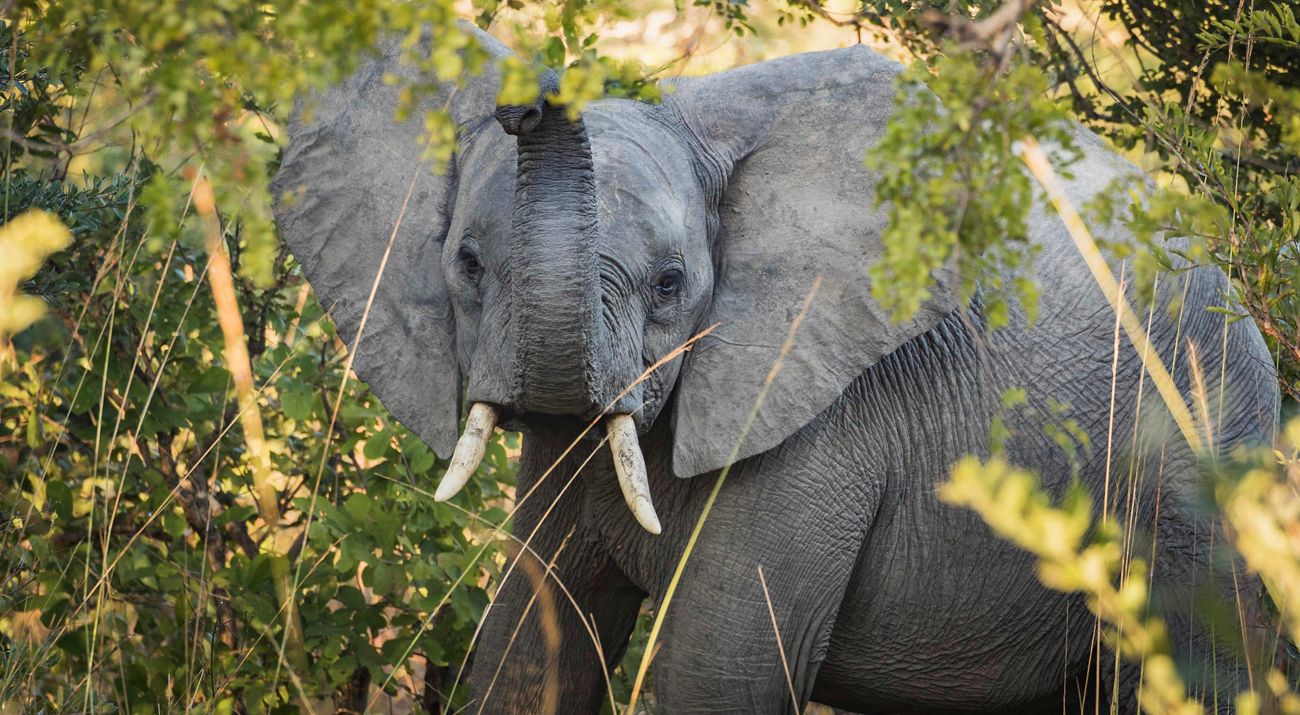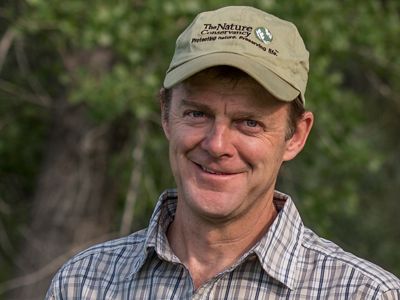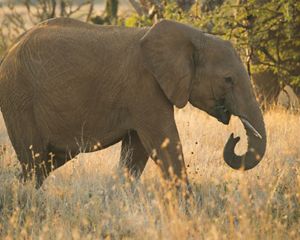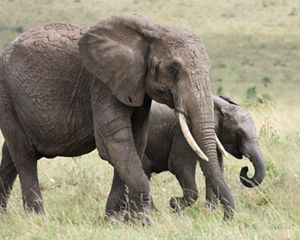
Documenting Zambia’s Elephants
An aerial survey provides new insight on this African country’s elephant population.

In September 2015, ecologists took to the sky to get a better picture of the state of elephants in Zambia as part of the Great Elephant Census. The results have the ecologists feeling cautiously optimistic. TNC Africa Conservation Director Matt Brown walks us through the results—and what they could mean for the future of conservation in Zambia.
What is the Great Elephant Census (GEC) and how does the Zambia survey fit in with it?
Zambia is one of 20 countries to participate in the Great Elephant Census, a Paul G. Allen project launched in 2013 with continent-wide results due out this year. It is the first pan-African elephant census in 40 years covering an estimated 95 percent of savanna elephant populations and using standardized data collection and validation methods.
Results from the Great elephant Census will serve several purposes including:
- Census results will provide the first reliable estimate of the total number of savanna elephants since IUCN’s African Elephant Status Report of 2006.
- Census results have already and will continue to inform in-country conservation efforts, showing where elephant protection is being effective and where it is not.
- Census results are being provided to IUCN as input to the 2016 Elephant Status Report that will be published in advanced of CITES 17th Conference of the Parties in September.
Why did TNC decide to get involved in the Great Elephant Census in Zambia?
The Nature Conservancy decided to get involved for a number of reasons:
- We wanted to make sure Zambia was included in the 20 country elephant count as this was the first time that multiple countries were being surveyed with a common methodology at the same time.
- We were asked by Paul G. Allen’s Vulcan Inc. to assist them with this effort.
- We feel this information from good science is needed to help inform management and investment decisions.
- TNC was able to play a role in gaining a broader understanding of the state of the species across the continent.
Tracking poaching is very difficult — poaching takes place in remote areas and tusks are smuggled out. Elephants move constantly, and these are massive wilderness areas. Kafue National Park alone is the size of New Jersey. You can cover great distances and still only see a few elephants but that doesn’t give the full picture. That’s why a scientifically designed and executed census was so needed and is so valuable.
Why are elephants important to monitor?
First of all, the elephant is an indicator species that tells you what is happening in terms of wildlife habitat at the landscape level. Elephants play a distinct role in maintaining a healthy ecosystem for the benefit of other species, such as preventing woody plants from crowding grasslands, and digging boreholes that are water sources during dry periods. Secondly, the elephant is a critical tourist asset, which makes it especially important for securing sustainable revenue needed for conservation activities and for securing community buy-in.
What did our involvement entail?
The Nature Conservancy worked closely with Zambia’s Department of National Parks and Wildlife (DNPW, formerly the Zambian Wildlife Authority, or ZAWA) to train their ecologists on data collection within the rigorous methodology required by the GEC protocol. Furthermore, the local ecologists had the opportunity to work with the technical consultant on data analysis and report writing resulting in increased capacity for the DNPW to be able to confidently carry out similar assignments in future. As the manager of funding provided by Vulcan Inc., TNC organized the more than 250 hours of survey flight time over the course of three weeks and hired an experienced independent technical consultant, Colin Craig, to lead the flights, data collection and analysis.
How was the survey conducted?
The survey was conducted according to the standard practice that most range states have been using based on the methodology that was designed by Norton Griffiths in 1987. Ecologists flew in light aircraft 300 feet above the ground over marked transects 300 meters wide in the sampling areas. In some cases, the transect was flown over by two aircrafts, giving the team an opportunity for real-time comparison of the data collected.
We have confidence in the rigorous methodologies used for the Great Elephant Census, and the data we have now is more standardized and thorough than what was previously available. It can also be aggregated with the other countries to provide a pan-African picture of the status of savanna elephants.
What do the results show?
The results show that, overall, the elephant population in Zambia may be stable, but with large differences between different parts of the country. Turning first to numbers of live elephants, the censuses suggested that elephant numbers are stable (or possibly even increasing) in the two largest elephant landscapes, Luangwa and Kafue. In the third landscape, Lower Zambezi, numbers are declining. And in the fourth landscape, Sioma Ngwezi National Park, on the border with Angola and Namibia, elephant numbers are declining catastrophically, with the species almost extirpated.
The ecologists were not only counting live elephants, but also elephant carcasses and the approximate age of those carcasses. A “carcass ratio” — the ratio of dead elephants to all elephants (alive and dead) — of 2 percent to 8 percent is considered normal for a stable or increasing population. The overall carcass ration for Zambia was estimated at 4.2%, meaning that the observed deaths were within sustainable levels and that the country’s population of elephants was stable to increasing, corroborating the live elephant counts.
Three of the four focal areas of the survey had carcass ratios of less than 8 percent. Additionally, the vast majority of the carcasses spotted were between 1 and 10 years old, indicating that poaching may have been on the decline in those areas for several years.
Sioma Ngwezi National Park had a carcass ratio of 85 percent, confirming a steeply declining population there. It’s the only area surveyed where fresh carcasses — indicating the elephants were killed within the last month — were recorded.
What is your initial reaction to the findings?
We are cautiously optimistic about the findings from the aerial surveys. The results clearly show that the work that has been put in place by ZAWA and partners like Game Rangers International (GRI), South Luangwa Conservation Society, and Frankfurt Zoological Society are yielding positive results.
For example, The Nature Conservancy has been supporting GRI’s anti-poaching efforts in Kafue National Park for the last three years. We believe that this increased enforcement has effectively reduced poaching numbers in the park, which is especially evident in areas where GRI has an active presence.
How else is The Nature Conservancy helping to protect elephants in Zambia?
Our work focuses on helping communities gain increased management authority over their land, which will allow them to regulate — and therefore benefit from — natural resource uses, including ecotourism.
Population estimates from the survey indicate that nearly one-third of the elephants in the greater Kafue ecosystem live outside of the national park boundaries. Empowering communities in these areas to benefit from healthy wildlife and landscapes is a first step toward ensuring a stable or increasing population.
Where do we go from here?
As with the overall objective of the GEC, this census is helping to bring more people to the table and to prioritize the conversation around elephant protection initiatives. Compiling this data was a crucial step forward, but it’s definitely not the last step. This census will serve as a catalyst to better determine how to allocate scarce resources and what can be done to improve elephant protection efforts across the country. Protection initiatives may need to be intensified in areas where the elephant population is facing more significant threats.
The government has indicated that they will launch a working group to develop a way forward. TNC will participate along with other stakeholders to determine not only how we can continue to secure this population, but how we could build on our successful initiatives to see the elephant population grow.


